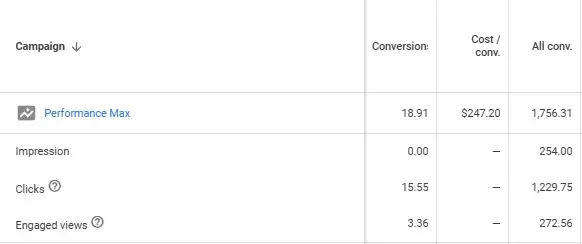Unmasking Performance Max: How Google’s “Full Funnel” Solution Prioritizes Retargeting
Performance max was heralded as the new way to run full funnel campaigns on Google. The only campaign you will ever need ushering in an era of less control and less reliance on keywords, or so it was supposed to be…
In reality, performance max has some flaws as it’s based on an algorithm which marketers have worryingly little control over. Chief among these is its reliance on conversion data as a method of optimizing.
In theory, this could work – find where the most conversions are coming from and do more of that. However, this causes Google to overdeliver where it sees a high conversion rate, namely branded search.
This leaves two options: keep targeting brand, exclude brand
Brand Targeting Dilemma
Targeting brand means performance max drives conversions very efficiently but mostly because it is targeting branded search queries. This helps with optimizing the campaign, but will teach the campaign to prioritize brand traffic in the future.
To avoid spending too much on brand, it’s wise to scale back or pause brand search campaigns.
Google added an option to exclude brand terms from Performance Max back in June 2023 in response to backlash from the community that Pmax restricted advertiser control too much.
To set this up, a brand list needs to be created with all possible variations of the brand name. This will be added as an excluded brand list within the Pmax campaign settings.
The result, most branded search will be removed from targeting. This can be verified in the insights under the search terms report. There’s always the chance that some disparate brand terms get through, but this is a mostly effective solution.
Strategic PMax Implementation: Controlling Your Retargeting Budget
Now the campaign only targets non-brand search and most likely the cost per conversion increased significantly. So, Performance Max isn’t doing as well as it may have seemed when brand was being targeted…yes and no.
It’s been optimized to find brand traffic, and as I mentioned earlier, Performance Max is almost entirely controlled by an algorithm which advertisers can’t control. This means that when you reset a setting like excluding brand traffic, you’re also resetting its optimizations.
Essentially, it’s going to run like a new campaign and cost will increase in the short term. It’s smart to decrease the budget for the first 2-4 weeks to limit any performance decreases.
At least now it’s not mostly targeting branded search. One step closer to the full funnel campaign that Google initially promised. It’s likely the campaign drove some conversions from non-branded search as well. Expect the campaign to prioritize non-branded search when brand is excluded.
Measuring True Channel Performance with Custom Analysis
Once the campaign has had 3 months to completely optimize, it should distribute impressions more widely across the Google properties. This can be determined by the cost per mille (CPM) or cost per thousand impressions. If it’s high (above $100) then it is likely the campaign is mostly targeting search inventory.
If the CPM is in the mid-range ($30-100), then there is likely some Discovery and YouTube inventory in the mix. If the CPM is below $30, most of the traffic is being driven through YouTube, Discovery, or the Google Display Network (GDN).
Here’s a look at the CPM in the test I ran.

The CPM decreased over a period of three months as the campaign optimized away from non-branded search toward display, Discovery and YouTube. The reason for this, retargeting.
This is not inherently a bad thing either.
Branded search is efficient, but retargeting is almost equal as well. Low-cost conversions can be driven when retargeting ads capture the last click, and Performance Max is able to retarget freely – no reach reporting, no frequency controls.
To this end, Performance Max works very well as an all channels retargeting campaign – rather than a full funnel strategy as Google promised. You can verify this a couple ways.
Maximizing Performance Max Retargeting
A brilliant marketer, Mike Rhodes, has developed a script that shows a breakdown of Performance Max spend per channel. This helps further verify what tactics Performance Max is prioritizing. A couple caveats:
- Shopping Display Ads are bucketed into ‘Display’
- There is no distinction for view vs click conversions
- Data is only available for the last 30 days
To better analyze performance, looking at the ‘ad event type’ segment in Google Ads is very insightful. You can see a breakdown of view, engaged view, and click conversions.

Campaigns with high volumes of impression and engaged view conversions are more retargeting focused. This happens as a result of higher display impression/video delivery to site visitors closer to point of conversion.
This presents an opportunity: using performance max retargeting to create effective low funnel engagement. The key to success is putting safeguards in place to ensure performance max can’t overspend.
Using a restrictive Target CPA (see how Target CPA works) with low funnel conversion (lead or sale) will effective restrict spend to only those that are closest to converting. In turn, the campaign will spend less as it only looks for these high intent users.
Aligning Expectations with Performance Max’s Actual Capabilities
In summation, learn what to expect and you won’t be disappointed. Performance max is effective at keeping your brand top of mind, but falls short at introducing the brand to new users. An intentional strategy to use Performance Max for retargeting with a Target CPA and low daily budget will limit any risk of overspending on those that are already brand-aware.

Pingback: Meta Ads Optimization Goals Explained: Why Conversion Campaigns Outperform Awareness & Engagement – Five to Nine
Pingback: Google Demand Gen - What to Know For 2025 - Five Nine Strategy